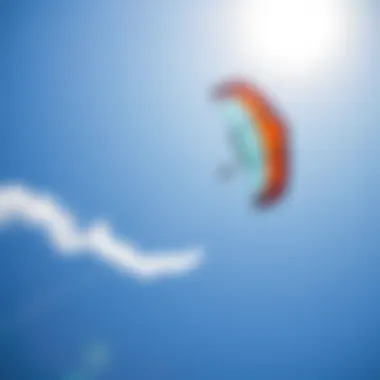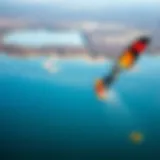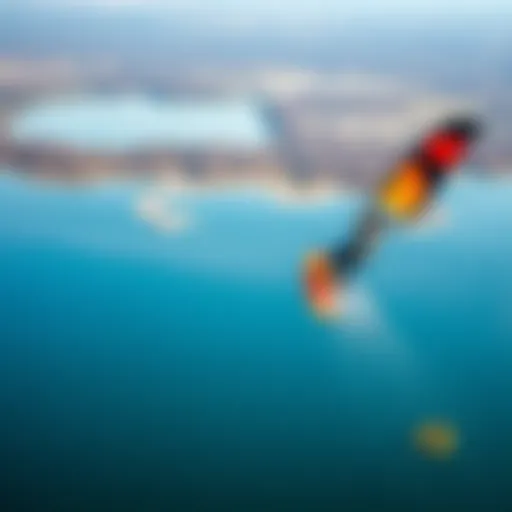Comprehensive Guide to Power Kites for Enthusiasts


Intro
Power kites are not just simple pieces of fabric strung together with ropes; they are complex instruments of thrill and adventure. The market for these kites has burgeoned over the past decade, catering to a diverse range of enthusiasts from novices eager to take their first flight to seasoned kite veterans pushing the limits of what power kites can do. Understanding this market encompasses various dimensions, including the types of kites available, key specifications that affect performance, and essential buying considerations.
This discussion aims to demystify the often overwhelming array of options—helping you navigate through factors like size, power, and design. Familiarizing oneself with power kites opens doors to many enjoyable experiences: from kiteboarding on picturesque beaches to incredible acrobatic displays high above summer festivals. Whether you’re just dipping your toes in or you’re a seasoned flyer chasing the next adrenaline rush, choosing the right power kite is crucial.
In this guide, we will delve into the essential gear needed for kiteboarding, the specific techniques you'll want to master, and insights that will empower you to make informed decisions when selecting your next power kite. The right blend of understanding and skill can lead to extraordinary experiences, and we aim to provide the information needed to elevate your kiteboarding adventures to new heights.
To kick things off, let’s explore necessary gear and equipment that will set the stage for your kiteboarding journey.
Understanding Power Kites
Power kites are more than just colorful fabric in the sky; they represent a thrilling gateway into a world where the wind meets adrenaline. Understanding the intricacies of power kites is crucial for anyone looking to delve into kiteboarding or simply soar through the skies on a windy day. These kites are designed not only to fly but to harness the wind’s energy, offering a unique blend of recreation and sport.
The significance of grasping the concept of power kites lies in their mechanics and functionalities, which can greatly affect the user experience. Enthusiasts must appreciate how different shapes, sizes, and designs influence the kite’s performance. Recognizing these elements allows for smarter purchasing decisions and, ultimately, a more enjoyable time on the water or land. Moreover, understanding power kites cultivates a deeper appreciation for the engineering and design that goes into creating these dynamic tools.
Definition and Functionality
Power kites, specifically, are large kites that are used for traction. Unlike traditional kites which may simply serve as a playful pastime, power kites are engineered for harnessing significant pull from the wind. They consist of a main canopy, bridle lines, and control lines which together allow users to manage the kite's movement and direction.
When you think of functionality, consider these kites as tools for various activities—kitesurfing, snowkiting, or even just flying them on a beach. Their purpose isn't merely to float; they can pull riders on boards, skis, or even aid in land-based pursuits. The thrill often comes from mastering the control of these kites, which can reach impressive speeds when expertly handled.
The Dynamics of Lift and Control
Lift and control are the very heart of what makes power kites so exhilarating. Understanding how lift is generated can markedly improve both the performance of the kite and the thrill of your ride. When a power kite catches the wind, its design creates a difference in pressure on its surfaces, leading to lift. This phenomenon is not just a matter of physics; it’s about how you position and maneuver the kite in various wind conditions.
Learning to control the kite involves finesse—how you pull and release the control lines influences the kite’s behavior. A deft pull on one line can steepen the angle, allowing the kite to climb, while releasing can send it diving. A kite flyer must remain attuned to the wind’s whims, adjusting their actions in real-time. This interplay between lift, pressure, and rider input is akin to a conversation between the flyer and the kite, where each adjusts to the other's movements in response to external conditions.
Power kites promise not just an enthusiastic experience but challenge individuals to understand and navigate their environment. As such, this knowledge not only enhances performance but fosters a profound respect for the forces at play, making each session a blend of sport and artistry.
Types of Power Kites
When it comes to diving headfirst into the world of power kites, understanding the types of power kites available becomes crucial. Kiteboarding enthusiasts, whether beginners or seasoned pros, will find that different types of kites cater to varying skill levels, environments, and specific activities. This section unpacks the main categories: Inflatable, Foil, and Training kites, each possessing unique elements and advantages.
Inflatable Power Kites
Inflatable power kites are a favorite among many for their versatility and stability. Built with inflatable bladders, these kites are designed to maintain their shape even under challenging wind conditions. This feature not only enhances performance but also makes them easier to launch. Because they can be flown in a wider range of wind conditions, inflatable kites are particularly valuable for those who enjoy kiteboarding in diverse environments.
One of the standout qualities is their durability. The materials used in their construction often resist wear from both sun and saltwater, providing long-term value. Plus, they can be deflated easily for storage, making them a convenient choice for travel.
"Inflatable kites revolutionize the kiteboarding experience by allowing riders to harness more power effortlessly."
When considering an inflatable kite, keep in mind the specific aspects like size and wing shape. Larger kites typically generate more power, which can be exciting; however, they also require a bit more expertise to control effectively.
Foil Power Kites
Foil power kites take a different approach, relying on air pressure to maintain their shape. This design makes them lightweight, allowing for quick responses and agility in the air. Foil kites perform exceptionally well in lighter winds, which makes them appealing for those who prefer to kite in more subtle conditions.
The simplicity in their construction is another bonus. They come without the need for rigid frames, which minimizes the risk of damage when crash-landed. This quality can be reassuring for learners—less worry about expensive repairs means more focus on learning the ropes. Moreover, foil kites often feature multiple chambers; should one inflatable pocket fail, the others maintain structure, adding an extra layer of safety.
It's important to note, however, that foil kites can take time to master, especially when it comes to getting them up in tricky winds. Riders accustomed to the stability of inflatable kites may need time to adjust.
Training Kites
Training kites serve as an invaluable introduction to the world of power kiting. These smaller, less powerful kites are ideal for beginners and provide a gentle onboarding experience. They allow new riders to grasp the fundamentals of kite control without the overwhelming power that larger kites can unleash.
Designed to be safe and easy to handle, training kites usually come in sizes that enable effective management even in relatively low winds. Besides enhancing hand-eye coordination, these kites focus on developing an understanding of how to harness wind effectively—skills that directly translate to larger power kites later on.
A key benefit of using training kites is affordability. They offer a low-risk investment into the sport, allowing newcomers to explore whether this exhilarating pastime resonates with them. This way, they won't break the bank while trying to get their wings, so to speak.
In summary, understanding the types of power kites allows enthusiasts to align their choices with their specific goals, preferences, and skill levels. Whether it's the stability of inflatable kites, the agility of foil kites, or the meticulous learning curve provided by training kites, each type plays a distinct role in the broader kiteboarding experience.


Key Specifications to Consider
When it comes to selecting power kites, understanding key specifications is essential for both seasoned veterans and budding enthusiasts. These specifications can be the difference between a seamless flying experience and a frustrating day at the beach. Knowing the nuances of size, wind compatibility, and material durability will guide potential buyers to make a wise investment. Each kite’s characteristics influence not only its performance but also how it interacts with the environment.
Size and Aspect Ratio
Size is often the first consideration for kiteboarders. Larger kites catch more wind and generate more power, making them suitable for experienced flyers who want an adrenaline rush. On the other hand, smaller kites are easier to handle and ideal for beginners looking to hone their skills.
Aspect ratio, defined as the ratio of the span to the chord, also plays a significant role in how a kite behaves in the air. A higher aspect ratio translates to better lift and speed but can compromise stability, especially in gusty conditions. Conversely, a lower aspect ratio enhances stability, making it easier for beginner pilots to maintain control. Understanding the trade-offs of size and aspect ratio can dramatically impact your kiteboarding experience.
"The right size of a kite can make or break your day in the air. Don’t underestimate its importance."
Wind Range Compatibility
Each power kite has a specific wind range in which it performs optimally. This makes compatibility with local wind conditions a crucial consideration. For instance, kites typically have a labeled wind range that indicates the minimum and maximum winds they can effectively operate in.
Kiteboarders should assess their usual flying environments when choosing a kite. If your area often has light winds, leaning towards a model designed for low wind conditions could be wise. Meanwhile, for windy locales, a kite robust enough to withstand higher wind speeds will provide a thrilling experience without the risk of tear or blowout. Always check the wind forecast and match it with your kite's specifications before heading out.
Material Quality and Durability
The materials used in constructing a power kite significantly affect its lifespan and performance. High-quality materials such as ripstop nylon or polyester are common for their strength and light weight. Look for kites made with reinforced stitching and reliable seam technology to ensure they can withstand the pressures of flight and erratic wind conditions.
Durability is paramount because kites often endure harsh environmental elements, from UV exposure to saltwater. Investing in a kite crafted from robust materials means less frequent replacements and repairs, which in turn, saves both time and money. Therefore, consider specialized forums or user reviews to ensure the kite you choose has a good track record for durability.
In summary, understanding these key specifications—size, wind compatibility, and material quality—can enrich your flying experience, allowing you to pick the perfect power kite for your needs.
Where to Find Power Kites for Sale
Finding a suitable power kite involves more than just a trip to the local shop. It’s about exploring various avenues to secure the right piece that fits your needs and budget. The quest for power kites can unfold in many places, each with its distinct advantages and peculiarities. Knowing where to look helps ensure that enthusiasts—from amateurs to seasoned pros—can make an informed choice.
Online Retailers
The internet has transformed the way we shop. Within a few clicks, kite enthusiasts can access a plethora of brands, styles, and sizes available for power kites. Leading online platforms such as Amazon and specialized retailers like Kiteworld or Progression Sports offer extensive selections. Browsing online can be particularly advantageous due to:
- Wider Variety: You might come across several different designs and brands that your local store might not carry.
- User Reviews: Customer feedback can provide insights that specifications alone might not convey. You can often read experiences from other kite flyers, which could shape your decision.
- Time Efficiency: Shopping from the comfort of your home saves the hassle of driving around or dealing with store hours.
However, there are a couple of caveats to consider. Be cautious with assessments of product quality and reliability of the seller. Try to stick to reputable online vendors, ensuring that you avoid any potential scams.
Local Shops and Specialty Stores
The charm of visiting a local shop cannot be understated. Establishments that specialize in kites or outdoor sports gear often offer personal interactions that online stores can’t replicate. Local retailers provide the opportunity to:
- Inspect in Person: You can touch the materials, see the kite’s size firsthand, and sometimes even test it. Feeling the fabric and the weight makes a difference in your purchasing decision.
- Expert Guidance: Staff members at specialized stores tend to be passionate and knowledgeable. They can provide tailored advice based on your skill level and intended use, potentially saving you from making a poor purchase.
- Community Engagement: Many local shops act as community hubs where kite enthusiasts gather. You might discover local events, workshops, or even fellow flyers who share tips and experiences.
Visiting local shops, though, can limit your choices compared to online avenues. It’s wise to know in advance what specific items you’re interested in, but you may end up finding something unexpected, too.
Second-Hand Markets
Exploring second-hand markets can yield fantastic finds while also being budget-friendly. Places like eBay, Craigslist, or local Facebook Marketplace groups enable users to buy kites that have been gently used or sometimes even as good as new. The benefits of second-hand shopping include:
- Cost Savings: You will often find kites at reduced prices, allowing more room in your budget for accessories or upgrades.
- Unique Models: There is a chance to stumble upon vintage or less common models that are no longer produced.
- Learning Experiences: Engaging with previous owners allows for an exchange of stories and tips regarding specific kites, which can enrich your understanding and performance.
Nonetheless, always carefully inspect second-hand purchases. Look for signs of wear and tear, and if possible, meet the seller in person, allowing for a thorough examination before money changes hands.
"Always inspect a second-hand kite carefully; what looks good online may not be so close up."
In summary, knowing where to find power kites for sale can significantly impact your kiteboarding journey. Whether you prefer the convenience of online shopping, the hands-on experience of local stores, or the bargain opportunities in second-hand markets, each route offers unique advantages that cater to various needs.
Evaluating Pricing and Budgeting
When it comes to investing in power kites, evaluating pricing and budgeting holds a significant place in the decision-making process. Power kites come in various shapes and forms with features that can greatly vary in price. Understanding this landscape helps both the novice and experienced kite enthusiast navigate through their options without being led astray by flashy marketing tactics or misleading offers. Knowing how to assess value and cost will not only keep your wallet happy but also ensure you’re getting the most return on your investment in aerial thrills.
A well thought-out budget plays a crucial role in the overall kiting experience. Without it, you could easily find yourself in over your head, spending more on kites and accessories than you initially anticipated. With kites often priced between a couple hundred to well over a thousand dollars, having a clear perspective on pricing ranges can guide you towards making a smart purchase.


Price Ranges for Different Types
Power kites come in a range of types and sizes, each with its own price structure. Here’s a basic breakdown:
- Training Kites: Often the most affordable, these kites typically range from $50 to $200. They provide a great entry point for beginners.
- Foil Power Kites: Prices usually hover between $150 to $600. Quality and size can dictate this range significantly.
- Inflatable Power Kites: These tend to be on the pricier side, often ranging from $400 to over $1,000, depending on the brand and specifications.
- Specialized or High-Performance Kites: If you’re looking for something tailor-made for specific conditions or performance, expect to pay $700 or more.
This variety in pricing reflects the quality, durability, and design intricacies involved in creating these engaging kites.
Factors Influencing Cost
Several elements play a part in how much a power kite will cost:
- Materials Used: High-quality fabrics and reinforced stitching can drive up expenses but typically enhance durability and performance.
- Brand Reputation: Well-known brands like Ozone or Cabrinha command higher prices due to established track records and customer trust.
- Wind Range: Kites that perform well in a wider range of wind conditions generally come with a steeper price tag due to their versatile design.
- Included Accessories: Kites sold as part of a package that includes harnesses, lines, or other accessories may have a higher upfront cost but provide better value.
- Technological Features: Innovations such as adjustable bridle systems or lightweight materials can add to the expense but offer a breakthrough in performance.
- Market Trends: Supply chain dynamics and seasonal sales can influence how kites are priced, making timing crucial for budget-conscious buyers.
In summary, making an informed decision about pricing and budgeting is essential to ensure you select the right power kite within your financial comfort zone. By comprehensively evaluating types and understanding influencing factors, you set yourself up for a satisfying experience both in the store and out on the wind.
Making an Informed Purchase
When it comes to power kites, making an informed purchase is crucial for both novice and experienced kiteboarders. Understanding the nuances of specifications, local laws, and personal preferences ensures that you get a kite that not only meets your expectations but also enhances your experience on the water or in the sky.
Research and Reviews
The first step in making an educated decision involves thorough research. A quick search online can unveil countless options, but how do you determine which one is right for you? Websites dedicated to outdoor gear, such as Kiteforum or Reddit, provide a wealth of user-generated content, allowing you to sift through personal experiences. Reading various reviews can give insights into the performance of specific kites, their durability, and how they behave in different wind conditions.
Moreover, watching videos or tutorials on platforms like YouTube can also be extraordinarily informative. People often share firsthand experiences, showing how the kite performs in real time. Don't overlook forums dedicated to kiteboarding; they can offer direct lines of communication with seasoned enthusiasts who can answer your specific questions.
Where to Start
- Search for local kiteboarding clubs to connect with experienced riders who may provide insights on brands, models, and anything else that leaps to mind.
- Check out sites like Amazon and eBay for user reviews but be cautious of biased feedback. A mixed bag is expected; take note of the recurring themes.
"The best kite is the one that feels right in your hands and flies like it was made for you."
Adopting a comprehensive approach offers a balanced view, helping you weed out false claims and hone in on options that resonate with your needs.
Warranty and Return Policies
Equally important is the understanding of warranty and return policies. These factors can make a significant difference in your overall satisfaction and peace of mind. What happens if the kite doesn’t live up to its promises? Many reputable manufacturers offer warranties that cover defects in materials and workmanship. Therefore, before making a final purchase, always check the warranty specifics—this detail could save you from a costly mistake down the line.
A solid return policy is just as vital. If the kite doesn’t soar as you anticipated—due to size, performance, or simply not being your style—having the option to return or exchange it can save both time and frustration.
Key Considerations
- Always ask questions about the claims of durability and performance; this can often be a deciding factor in making your purchase.
- Don’t hesitate to compare policies across different sellers; one retailer might offer a more flexible return policy than another.
In summary, by carefully researching and understanding the warranty and return options, you empower yourself to make a more informed buying decision. In the world of power kites, where performance and satisfaction directly tie into your enjoyment, every minute detail counts.
Maintenance and Care for Power Kites
Taking proper care of your power kite isn’t just a chore; it’s a vital practice that ensures longevity and optimal performance. Like any piece of sports equipment, a kite requires some TLC to nurture its materials and mechanisms. Neglecting maintenance could lead to damage, resulting in diminished performance during those exhilarating high-speed descents or tricky maneuvers. Just as you'd care for a bike or a pair of hiking boots, keeping your power kite in prime shape can make all the difference when it’s time to hit the wind.
Cleaning Your Kite
A clean kite is a happy kite. After each session in the great outdoors, it's crucial to rid your kite of any sand, salt, dirt, or debris that has accumulated. This not only improves the kite's performance but also significantly extends its lifespan.
Here’s how you can tackle the cleaning process:
- Rinse with Fresh Water: Start by giving your kite a good rinse with fresh water to wash off any salt or sand. Make sure to do this immediately after use to avoid residue setting in.
- Use a Soft Cloth: For any stubborn spots, a soft cloth or sponge can work wonders. Avoid using anything rough that might scratch or damage the fabric.
- Dry Completely: Never pack your kite away while it’s wet; this can lead to mold and mildew. Lay it flat in a shaded area to dry completely before storing it.
- Check for Damage: While cleaning, inspect your kite for tears or wear. Early detection can save you from larger repairs down the line.
- Specialty Cleaners: If your kite picked up some stubborn grime, consider using a specialized cleaner designed for outdoor fabrics. Just be sure to follow the manufacturer’s instructions carefully.
"Regular cleaning can significantly enhance your kite’s performance and durability, making it a crucial part of kite care."
Storage Tips
Storing your power kite properly when not in use is just as important as cleaning it. Improper storage can lead to issues like warping, fading, or even permanent damage. Let’s dive into some useful storage tips:


- Use a Backpack or Bag: Most kites come with a storage bag or backpack. Always use this to prevent physical damage from items in the same space.
- Avoid Extreme Temperatures: Store your kite in a cool, dry place. High heat or extreme cold can degrade the materials over time.
- Keep Away from Direct Sunlight: UV radiation can weaken the fabric. If possible, store your kite indoors or cover it when stowed away.
- Roll, Don’t Fold: When packing your kite, roll it instead of folding. This technique prevents creasing, which can lead to weak points in the fabric.
- Account for Lines and Accessories: Ensure that lines and other accessories are also stored carefully. Tangled lines can become frayed and lead to unsafe flying conditions.
Taking the time to clean and store your power kite properly will pay off in the long run by enhancing your kite flying experience, keeping your kite in prime shape for many adventures to come.
Understanding Local Regulations
When it comes to enjoying the thrill of power kites, understanding local regulations cannot be overlooked. This is not just about following the rules; it’s about ensuring your safety and the safety of others in the vicinity. Different areas have unique laws pertaining to kiteboarding, and complying with these regulations is essential for both responsible enjoyment and avoiding potential fines.
Are you soaring through open skies or zipping across a beach? The type of location can significantly impact the rules you need to follow. For instance, some parks and beaches may have designated areas where kiteboarding is permitted, while others could restrict activity to certain times to minimize noise or conflict with other recreational users.
Acquainting yourself with the laws isn't just a bureaucratic task; it enriches your kiteboarding experience. Consideration of local regulations can:
- Enhance Safety: Knowing the proper zones and restrictions helps prevent accidents and injuries.
- Foster Community Relations: Building a good rapport with local authorities and fellow enthusiasts creates a more enjoyable environment for everyone.
- Protect the Environment: Being aware of environmental regulations minimizes impact on local wildlife and habitats.
Kiteboarding Laws and Safety Guidelines
Every kiteboarder must come to grips with the laws that govern kiteboarding in their chosen locale. It’s as easy as a quick search online for local regulations or a visit to community forums. Here’s what you should keep in mind:
- Licensing Requirements: Some regions may require permits to operate power kites, especially in public areas.
- Age Restrictions: Know what age groups are allowed to kiteboard in various areas, as some places have strict regulations to ensure the safety of minors.
- Equipment Regulations: Ensure that your power kite meets local safety standards. This might include using safety lines or specific types of materials.
- Distance from Other Activities: Usually, it’s mandated that kiteboarding isn't done near swimming areas or crowded beaches. Pay attention to signs and local maps showing no-fly zones.
It is recommended to check websites like *.gov for official guidelines and restrictions specific to your area, as these may vary widely.
Environmental Considerations
The thrill of kiteboarding can sometimes trump our awareness of the environment around us. Understanding the ecological impact of this sport is critical for maintaining the balance between enjoying nature and preserving it. Here's where you need to take stock:
- Wildlife Disturbance: Flying kites in areas with nesting birds can cause stress to wildlife during critical periods. Avoid these areas to help keep the local ecosystem thriving.
- Debris Management: Power kites can contribute to litter if not managed properly. Always clean up after yourself, including any broken kite parts or lines.
- Respect Nature: Be aware of fragile ecosystems, such as coastal dunes and wetlands, that may be disturbed by kiting activities. Familiarize yourself with appropriate access points to avoid trampling sensitive vegetation.
Outdoors enthusiasts are encouraged to participate in community-driven clean-up initiatives or to join discussions on platforms like reddit.com, focusing on responsible kiteboarding and environmental stewardship. This not only promotes a better understanding of local regulations, but also reinforces a sense of responsibility within the kiteboarding community.
Community Insights and Experiences
Understanding the community surrounding power kites is crucial for both new and seasoned kite enthusiasts. Engaging with others who share a similar passion can offer insights that you might not find in traditional guides or retailers. Learning from the experiences of fellow kite flyers can enhance your own kiteboarding journey. This section explores shared knowledge, safety tips, and collective advancements in the sport that come from community interactions.
Interviews with Enthusiasts
Interviews with kiteboarding enthusiasts provide a unique window into personal experiences, challenges, and triumphs. These narratives often go beyond the facts and figures about brands and equipment. For instance, an enthusiast might share how they struggled with the wind dynamics while learning but found a supportive local group that helped them navigate those initial hurdles.
- Insightful Anecdotes: Personal stories reveal not just technique but also emotional journeys. Whether it’s a family bonding over kite flying or overcoming fears of flying high, these anecdotes provide a human touch that enriches the learning process.
- Product Recommendations: Enthusiasts often discuss various brands and models based on their personal experience. Their views can guide potential buyers towards kites that have proven reliability and performance in real-world conditions, rather than just marketing claims.
- Community Events: Many enthusiasts mention local events and meetups focused on kite flying. Participating in these events not only hones skills but also allows for networking with fellow flyers, creating a sense of belonging.
Forums and Discussion Platforms
Online forums and discussion platforms serve as an invaluable resource for the kiteboarding community. Websites like Reddit and Facebook contain countless threads of shared experiences, insights, and advice. These platforms foster a real-time exchange of information that can be crucial for making informed decisions.
- Diverse Opinions: Users from various backgrounds contribute different perspectives on gear, techniques, and locations. This diversity enriches the knowledge pool, catering to a wide audience from beginners to seasoned pros.
- Safety and Regulations: Community platforms often discuss not only kite operation but also local regulations that might affect kite boarding. Enthusiasts share their knowledge of safe practices, helping newcomers avoid potential pitfalls.
- The Power of Collective Knowledge: Topics can vary from recommended gear setups to the latest trends in power kites. Users address problems others might face, tapping into collective wisdom that can save time, money, and frustration.
"Getting involved with the local kite community has not just improved my flying skills significantly, but it has also made my experiences on the beach so much richer!" - A passionate kite flyer.
Leveraging these community insights can greatly enhance your kiteboarding experience. When you connect with others, you're not just discovering new techniques or products but also forging relationships that can last a lifetime. As the world of power kites expands, so too does the community that nurtures and sustains it.
Future Trends in Power Kites
As the world embraces outdoor activities with greater fervor, the sector of power kites is evolving at an astonishing pace. From innovations that enhance user control to sustainable practices reshaping the manufacture of kites, the future looks bright for enthusiasts. Understanding these trends is crucial for kiteboarders and manufacturers alike. This section will shed light on what is coming down the pipeline, both technologically and environmentally, ensuring that you’re well-prepared for what lies ahead.
Technological Innovations
The integration of advanced technology in power kites has transformed how enthusiasts engage with this exhilarating sport. Recent advancements are making kites not only easier to fly but also safer and more efficient.
- Smart Kites: Imagine kites embedded with sensors that relay information about wind conditions, altitude, and even battery life (on powered kites). This data can optimize performance and help users adjust their flying techniques.
- Improved Materials: The industry is seeing a shift towards lighter, stronger materials. Dyneema and other advanced fabrics are being explored, offering durability while reducing weight, resulting in better handling and performance.
- Design Innovations: The aerodynamic designs are continually being refined. New shapes and configurations are being tested to maximize lift and control, allowing users to perform maneuvers that were previously thought impossible.
- Remote Control Features: Emerging designs include options for remote control, making it easier for beginners to learn. This has the potential to change the way instructors teach kiteboarding, reducing the steep learning curve often associated with the sport.
"Innovation is the engine of growth in the kiteboarding industry, with each new kite improving the experience for all levels of kiteboarders."
Sustainability in Manufacturing
As environmental issues take center stage, the kiteboarding industry is responding with initiatives focused on sustainability. This trend is not just beneficial for the planet; it also appeals to environmentally conscious consumers who are increasingly looking for eco-friendly products.
- Biodegradable Materials: Some manufacturers are beginning to experiment with biodegradable materials that do not contribute to the plastic pollution crisis when discarded.
- Recycling Programs: Within certain brands, efforts are underway to establish kite recycling programs. These programs aim to mitigate waste by allowing customers to return old kites for repurposing or recycling.
- Energy-Efficient Processes: Advances in manufacturing processes are leading to reduced energy consumption. More manufacturers are implementing renewable energy sources in their production, further decreasing their carbon footprint.
- Educational Campaigns: Kite brands are promoting environmental stewardship by engaging in campaigns that educate customers about responsible kite use, such as proper disposal of materials and respect for nature during flying.
As kiteboarding enthusiasts, these trends signal a shift not just in how we purchase and use power kites but in our role as stewards of the environment. Staying informed on these developments is essential for making enlightened purchases that reflect your values while enjoying the sport you love.















